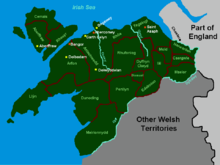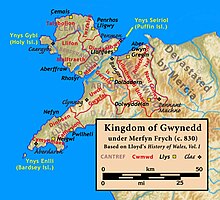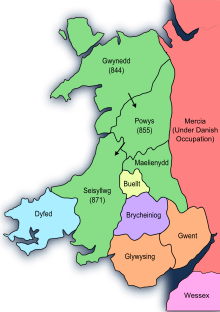Ethil ferch Cynan
Ethil ferch Cynan (Ethil daughter of Cynan, also called Ethyllt or Ettil, * 8th century; † after 814/815) was a Celtic princess from the dynasty who, according to traditional genealogies from Cunedda Wledig ap Edern (cl. Around 450) who founded the medieval Kingdom of Gwynedd in northwest Wales . She became the heir to the kingdom as the last of the dynasty. Their significance lies in the fact that their descendants combine the legacy of three Celtic dynasties, which according to traditional genealogies go back to late antiquity . At the same time she was a European ancestor, since the later princes of Wales , who ruled until 1293, and subsequently all later kings of England and numerous European dynasties and families in addition to the House of Tudor descended from her.
origin
The Ethils family originally comes from the so-called Hen Ogledd (the Old North) of Britain , i. that is, from the part of the country which today corresponds to the south of Scotland and the north of England . There lived a group of people called "Gwŷr y Gogledd", ie, the men from the north, who spoke their own Celtic language, Cumbrian , and who had been ruled by indigenous dynasties since late antiquity, who were federates in the service of Roman Empire exercised local administration and defense.
According to the traditional genealogies, the oldest historically regarded ancestors of Ethil had Roman first names, such as Tacitus (Tegid), Paternus (Padarn) and Aeternus (Edeyrn), although they were probably of Celtic or Roman-Celtic origin.
The closer progenitor of Ethils, the warlord Cunedda Wledig ap Padarn (Cunedda the chief, son of Paternus), who, according to tradition, had fought off attacks by the Picts on Hadrian's Wall with fighters from the Celtic tribe of the Votadini , turned around 450 with his troops and his Sons of Manau Gododdin - the modern region of Clackmannanshire in Scotland - to North Wales to drive away the Scots (Irish) that spread there . From the conquered area he created the kingdom of Gwynedd and became the progenitor of the dynasty that ruled there for over three hundred and fifty years.
Ethil's father, Cynan Dindaethwy ap Rhodri Molwynog (* around 740, † 816), ruled as King of Gwynedd from 798, but was overthrown in 816 by his brother Hywel ao Rhodri Molywynog, who ruled as the last of his house as King of Gwynedd until 825. Ethil's mother Mahallt (Mathilda) was given as a daughter of a Lord Flint.
Descent from Cunedda
The traditional line of the first dynasty of the kings of Gwynedd is according to the Harleian Genealogies ascending from Ethil as follows:
- Tacit ap Cein (Tacitus son of Cein)
- Padern Beisrudd ap Tacit (Paternus with the red robe, son of Tacitus
- Edern ap Patern Beisrudd
- Cunedda ap Edern called Cunedda Wledig (Cunedda the Emperor)
- Einion Yrth ap Cunedda (Einior of the impetuous) (around 470 - 480)
- Cadwallon Lawhir ap Einion (around 500 - 534)
- Maelgwn Hir ap Cadwallon (Maelgwn the Long) (534 - 547)
- Rhun Hir ap Maelgwn from 547 to 580
- Beli ap Rhun king from 580 to 599
- Iago ap Beli King of Gwynedd 599 to 616
- Cadfan ap Iago King Gwynedd from 616 to 625
- Cadwallon ap Cadfan King of Gwynedd 625 to 633)
- Cadwaladr Fendigaid (the Blessed) ap Cadwallon King from 654 - 682
- Idwal Iwrch ap Cadwaladr König from 682 - 720
- Rhodri Molwynog ap Idwal King from 720 to 754
- Cynan Dindaetwy King from 798–816. He died in 816 according to the Annales Cambriae
- Ethil (Ethyllt, Esylt) ferch Cynan
Life
No biographical details are known about the life of Ethil, but it was shaped by developments in the Gwynedd Kingdom of her time. Her father, Cynan Dindaethwy, could not succeed him after the death of his father, Rhodri Molwynog ap Idwal, who ruled as King of Gwynedd from about 720 to 754. This is because Caradog ap Meirion of Rhos, another pretender to the crown, took control of Gwynedd in 754 and exercised it until his death in 798.
She therefore lived for many years under the rule of King Caradog, while her father had to wait over forty years for his succession to the throne. This could be due to the fact that Ethil's father Cynan was still a child when his father King Rhodri died in 745, which is why a reign was provided, which however degenerated into a long reign. One event from this period is the settlement of a long-running religious dispute about the correct date of Easter in 768 , when the Celtic Church in Wales finally yielded to the urging of Rome and adopted the Roman Catholic Church's method of calculating the date.
King Caradog finally died in 798 - according to the Annales Cambriae , he was killed by Saxons (presumably from the Kingdom of Mercia ) by having his throat cut - whereupon Ethil's father, Cynan Dindaethwy ap Rhodri, became king of Gwynedd and reigned until 816. However, he resided unlike later kings, not in Aberffraw in the west of Anglesey , but in Llanfaes (now a small village) on the coast of the Menai Strait in southeastern Anglesey.
Her father's brief reign, however, was marked by bitter power struggles, especially with the pretender Hywel, about whose origins differing opinions exist. According to the genealogy of Jesus College MS 20 and also according to the Early British Kingdoms website, Hywel was a son of Caradog ap Meirion. According to other sources and historians, such as David Walker and John Edward Lloyd, this Hywel was a brother of Ethil's father and was called Hywel ap Rhodri Molwynog. However, there is a lack of reliable information so that these relationships are not entirely certain. This civil war raged in Anglesey between 812 and 816 and ended in the defeat and death of her father, whereupon his supposed brother Hywel ap Rhodri ascended the throne in 816. Since he died in 825 without heirs, Ethil became the sole heir to the kingdom of Gwynedd.
Marriage and offspring
Ethil married Gwriad ap Elidyr (Gwriad son of Elidyr), also called Gwriad Manaw or Guriat, (* around 750), king of Ynys Manaw (the Isle of Man ). He was a son of King Elidyr ap Sandef. Otherwise you hardly know anything about your life. However, a stone cross, the Guriat Cross, which is located near Maughold in the north of the Isle of Man, reminds of him. It is noteworthy that two important Celtic dynasties were united in it. In the male line he came from the Harleian Genealogies from the Coelings dynasty, which is derived from King Coel Hen (Coel the Old), also called Coel Codebawg (Coel the Protector), who was named after John Morris at the time of Roman Britain around 400 "Dux Brittaniarum" (Duke of the British) was the last Roman military governor in Hen Ogledd (the old north), that is, in the Solway / Carlisle region between southern Scotland and northern England and is said to have ruled in Manaw Gododdin (area around the Firth of Forth ) and later became the High King of Northern Britain. In the female line, Gwriad descends through his paternal grandmother Celemion ferch Tutagual from the likewise Celtic House of Kings of the Isle of Man, who according to Pedigree No. 4 of the Harleian Manuscript 3859, which contains the genealogies of the "Men of the North", in twelfth generation to Anthun (or Dunaut), an alleged "son" of Magnus Maximus (* around 335, + 388). Maximus was Roman governor in Britain from 380 and Western Roman (counter) emperor from 384 to 388, who played an important role in Welsh legend as "Macsen Wledig". In Ethil's son Merfyn Frych ap Gwriad, the legacy of three Celtic dynasties of Britain was united, which ruled the region around Carlisle in Scotland, the Isle of Man and Gwynedd in Wales and which, according to the traditional genealogies, go back to late antiquity.
progeny
-
Merfyn Frych ap Gwriad (Merfyn the Freckled, son of Gwiyad) King of Gwynedd (825–844), ∞ Nest ferch Cadell, a daughter of Cadell ap Brochfael King of Powys (773–808). She was the heir of her brother King Cyngen ap Cadell, who in 855 was expelled by his nephew - their son Rhodri Mawr (the Great) - King of Gwynedd (844-878) and died on a pilgrimage to Rome. Before that, however, Cyngen had the "Pillar of Eliseg" erected near Llangollen in honor of his grandfather, King Eliseg / Elisse von Powys, which includes his line of families except for the British Hochkönig Vortigern - who called the Saxons Hengist and Horsa into the country - and his wife Sevira , a daughter of Magnus Maximus.
-
Rhodri Mawr (the Great) King of Gwynedd (844-878), King of Powys (from 855) and since 872 King of Seisyllwg (Ceredigion and Ystrad Tywi), fell in 878 in the battle against the English under King Alfred the Great († 899) ). & Angharad T. v. Meurig ap Dyfnwallon, King of Seisyllwg. He had several sons, including in particular:
- Anarawd ap Rhodri King of Gwynedd (878–919), called: "King of the British", who recognized King Alfred the Great of England as overlord and progenitor of the later kings and from 1152 (submission of King Owain Gwynedd (ruled 1137–1170) under King Henry II of England) was Prince of Gwynedd. The last prince, Dafydd III. (1282–1283) had King Edward I of England hang and quartered in Shrewsbury in 1283 .
- Cadell ap Rhodri King of Seisyllwg (878–909) ancestor of the kings, from 1135 Prince of Deheubarth who ruled until 1201. In the female line, the princes of Powys, who were independent from 1075 and ruled , divided into the lines Powys Wenwynwyn (in the south) and Powys Fadog (in the north), ruled until 1216 and 1269 respectively. In the female line, the House of Tudor also descends from the Princes of Deheubarth, as its progenitor, Ednyfed Fychan ap Cynwrig, Seneschal von Gwynedd († 1246), Gwenellian, a daughter of Rhys ap Gruffydd, married Prince of Deheubarth 1153-1197.
- Gwriad ap Merfin Frych. He fell with his older brother Rhodri Mawr 878 in the fight against the English.
-
Rhodri Mawr (the Great) King of Gwynedd (844-878), King of Powys (from 855) and since 872 King of Seisyllwg (Ceredigion and Ystrad Tywi), fell in 878 in the battle against the English under King Alfred the Great († 899) ). & Angharad T. v. Meurig ap Dyfnwallon, King of Seisyllwg. He had several sons, including in particular:
literature
- Mike Ashley: The Mammoth Book of British Kings and Queens. Constable Publishers, London, reprinted 2000; ISBN 1-84119-096-9 .
- Burke's Guide to the Royal Family. First Edition, Burke's Genealogical Series, Burke's Peerage Limited, London 1973, ISBN 0-220-66222-3 .
- John Davies: A History of Wales (First ed.), Penguin Group, London 1990 (published 1993), ISBN 0-7139-9098-8 .
- David Nash Ford: Early British Kingdoms online
- John Edward Lloyd: A History of Wales from the Earliest Times to the Edwardian Conquest. I (2nd ed.), Longmans, Green and Co, London 1912.
- John Morris: The Age of Arthur. Weidenfeld & Nicolson, London 1973, ISBN 0-297-17601-3 .
- Sir Charles Oman: England before the Norman Conquest. Methuen & CO LTD. London 1938.
- Phillimore, Egerton, ed. (1887), "Pedigrees from Jesus College MS.20", Y Cymmrodor, VIII, Honorable Society of Cymmrodorion, * R. Cunliffe Shaw: The Men of the North. self-published, without year.
- David Walker: Medieval Wales. Cambridge Medieval Textbooks, 1990, ISBN 0-521-31153-5 .
swell
- Annales Cambriae
- Nennius (9th century), Historia Brittonum
- Harleian Genealogies in the Harleian Collection of the British Library , Harleian Manuscript 3859,
- Genealogies from Jesus College Manuscript 20 (Oxford)
- Bonedd Gwyr y Gogled (The Ancestors of the Men of the North)
See also
Individual evidence
- ^ Charles Cawley, Mediaeval Lands http://fmg.ac/Projects/MedLands/WALES.htm#_Toc389126134
- ↑ Jesus College MS 20 Jesus College MS 20 "The Descendants of Cunedda"
- ↑ Harleian genealogies. British Library, Harleian Manuscript 3859
- ^ R. Cunliffe Shaw: The Men of the North. self-published, without year.
- ↑ a b David Nash Ford: EBK: King Cynan Dindaethwy of Gwynedd In: earlybritishkingdoms.com , accessed on October 16, 2017.
- ↑ Harleian Genealogies [1]
- ^ R. Cunliffe Shaw, The Men of He North, self-published by the author, no year. Family table after page 136
- ↑ Phillimore, Egerton, ed. (1887), "Pedigrees from Jesus College MS.20", Y Cymmrodor, VIII, Honorable Society of Cymmrodorion, pp. 77-92
- ↑ Dies after then Annales Cambriae [2] 547 of the plague
- ↑ Dies after then Annales Cambriae [3] 682 of the plague
- ↑ He died according to the Annales Cambriae in 754. Annales Cambriae [4]
- ↑ Annales Cambriae [5]
- ^ Sir John Edward Lloyd: A History of Wales from the Earliest Times to the Edwardian Conquest . Longmans, Green, 1912, pp. 133 ( limited preview in Google Book search).
- ↑ Lloyd, John Edward (1911), A History of Wales from the Earliest Times to the Edwardian Conquest, I (2nd ed.), P. 201; London: Longmans, Green, and Co (published 1912)
- ↑ David Walker, Medieval Wales; Page 5 with family tree, Cambridge University Press, Cambridge 1990, ISBN 0-521-31153-5 .
- ↑ Lloyd, John Edward (1912): A History of Wales from the Earliest Times to the Edwardian Conquest. I (2nd ed.), P. 231; London: Longmans, Green and Co
- ↑ Davies, John (1990): A History of Wales (First ed.), London: Penguin Group (published 1993), ISBN 0-7139-9098-8 .
- ↑ Mike Ashley "The Mammoth Book of British Kings and Queens"; Constable Publishers, London, reprinted 2000; ISBN 1-84119-096-9 , p. 346
- ^ Sir John Edward Lloyd: A History of Wales from the Earliest Times to the Edwardian Conquest . Longmans, Green, 1912, pp. 323 ( limited preview in Google Book search).
- ↑ http://www.kmatthews.org.uk/history/gwyr_y_gogledd/index.html
- ^ John Morris: The Age of Arthur , Weidenfeld & Nicolson, London 1973, ISBN 0-297-17601-3 .
- ^ Cunliffe Shaw: The Men of the North. P. 138, family tree after page 136
- ^ Cunliffe Shaw: The Men of the North. P. 139, family tree after page 136
- ↑ Burke's Guide to the Royal Family, First Edition, p. 325; 1973, London Burke's Peerage Limited ISBN 0-220-66222-3
- ^ Sir Charles Oman, England before the Norman Conquest, A History of England in Eight Volumes, Vol. I, page 465; Methuen & CO. LTD. London, 1938
- ↑ Burke's Guide to the Royal Family, First Edition, page 323; 1973 London Burke's Peerage Limited, ISBN 0-220-66222-3
- ↑ Burke's Guide to the Royal Family, First Edition, p. 325; 1973, London Burke's Peerage Limited, ISBN 0-220-66222-3
- ↑ Burke's Guide to the Royal Family op. Cit. P. 324 and 325
Web links
- Early British Kingdoms: Royal Biographies (English)
- Post Roman kingdoms - Gododdin (English)
- The early British kings (English)
| personal data | |
|---|---|
| SURNAME | Ethil ferch Cynan |
| ALTERNATIVE NAMES | Ethyltt ferch Cynane; Ettil ferch Cynan |
| BRIEF DESCRIPTION | Heiress to the Kingdom of Gwynedd (Wales) |
| DATE OF BIRTH | 8th century |
| DATE OF DEATH | after 814 |



